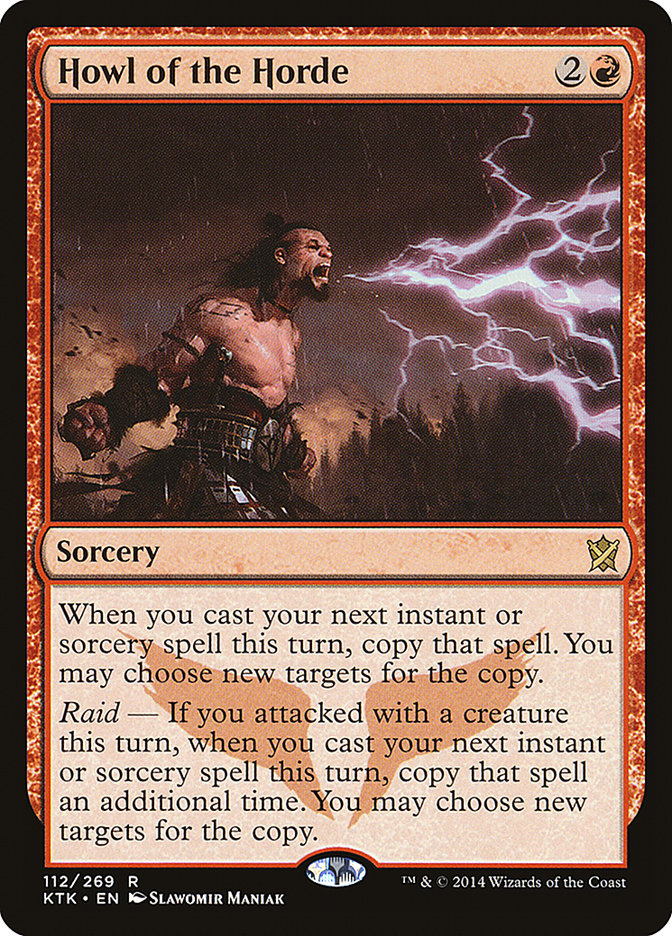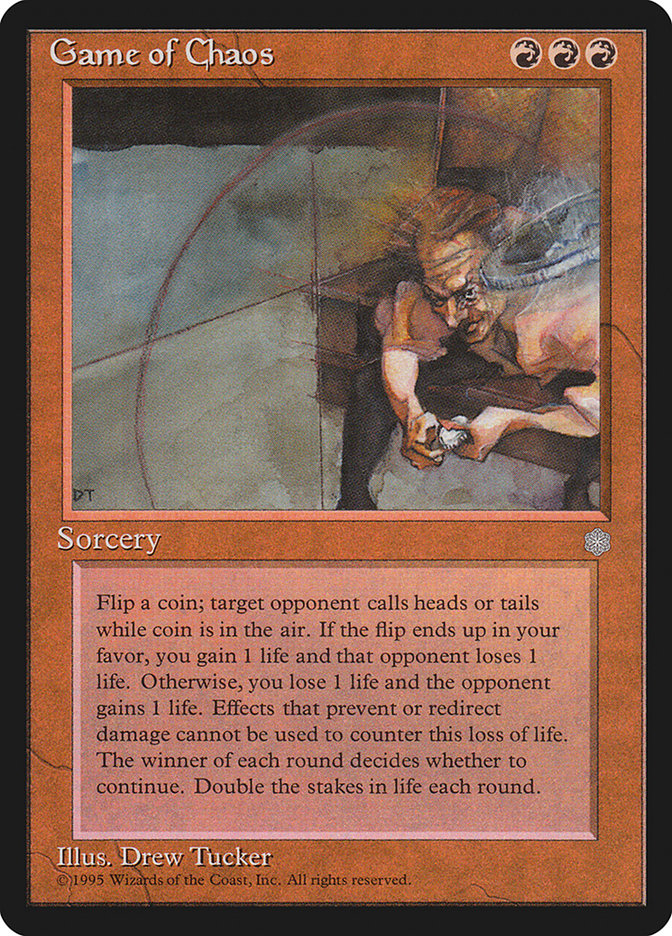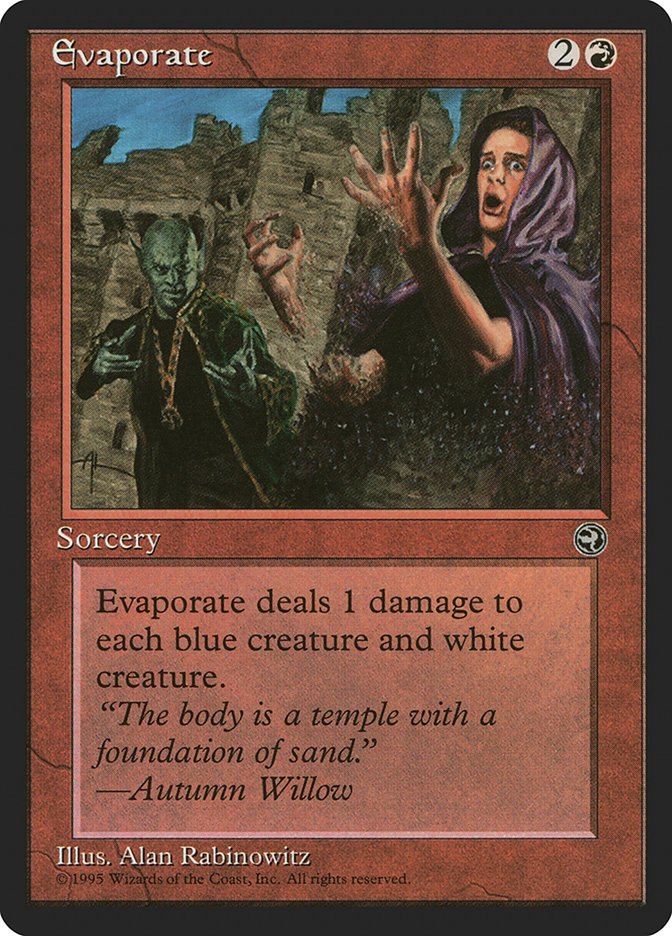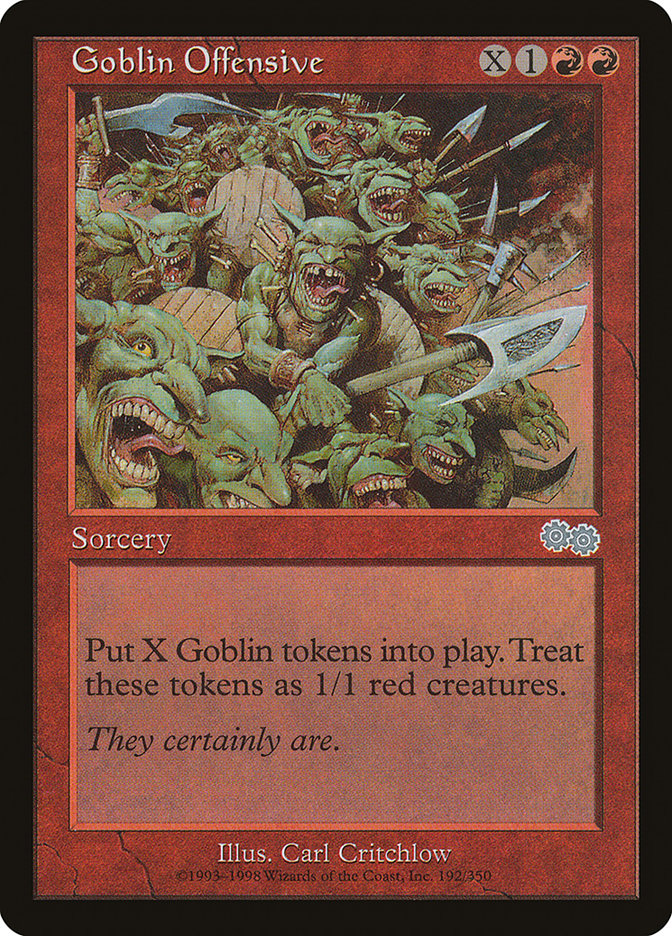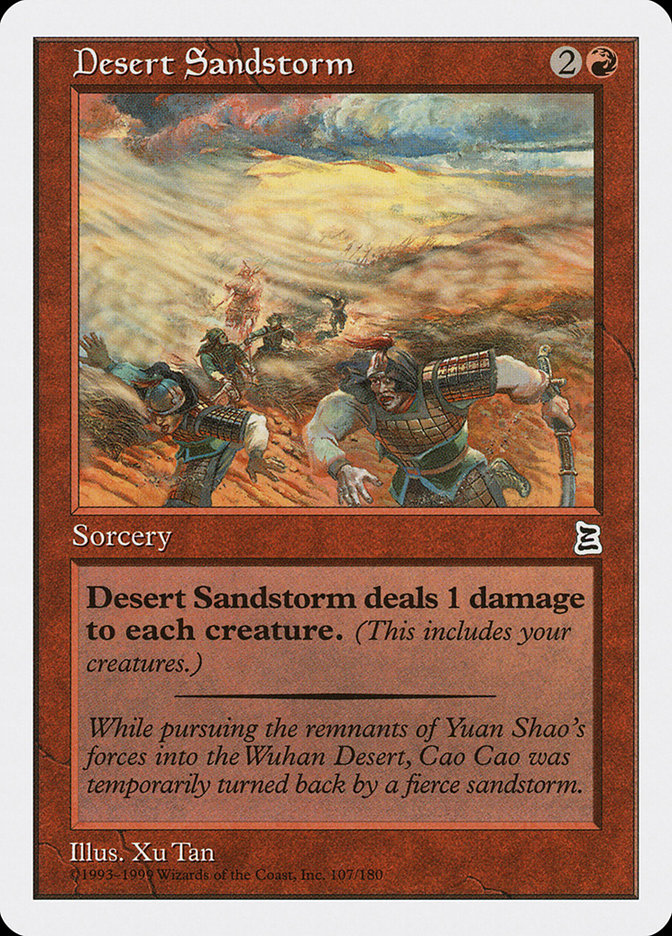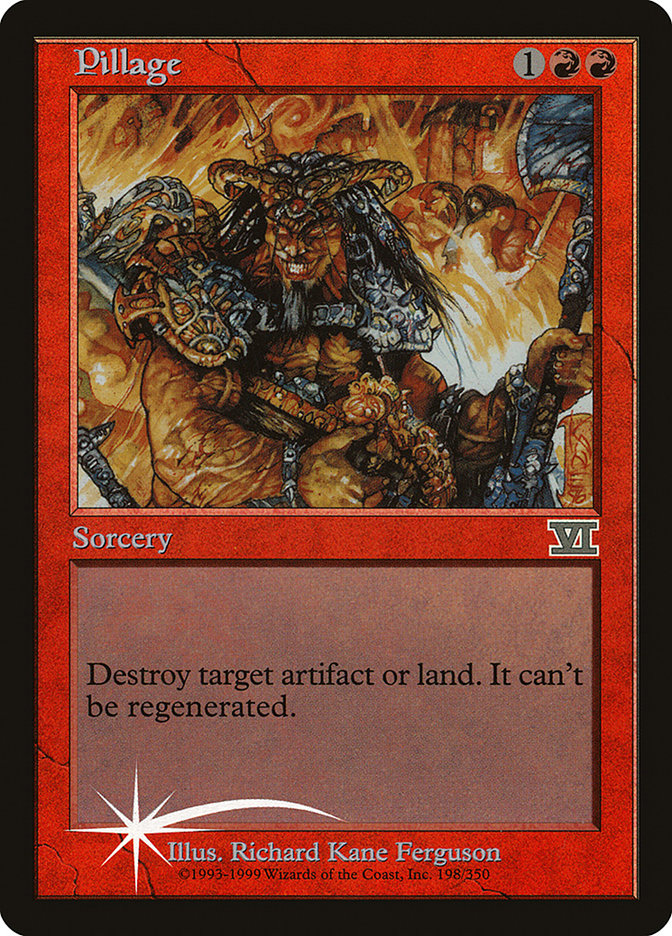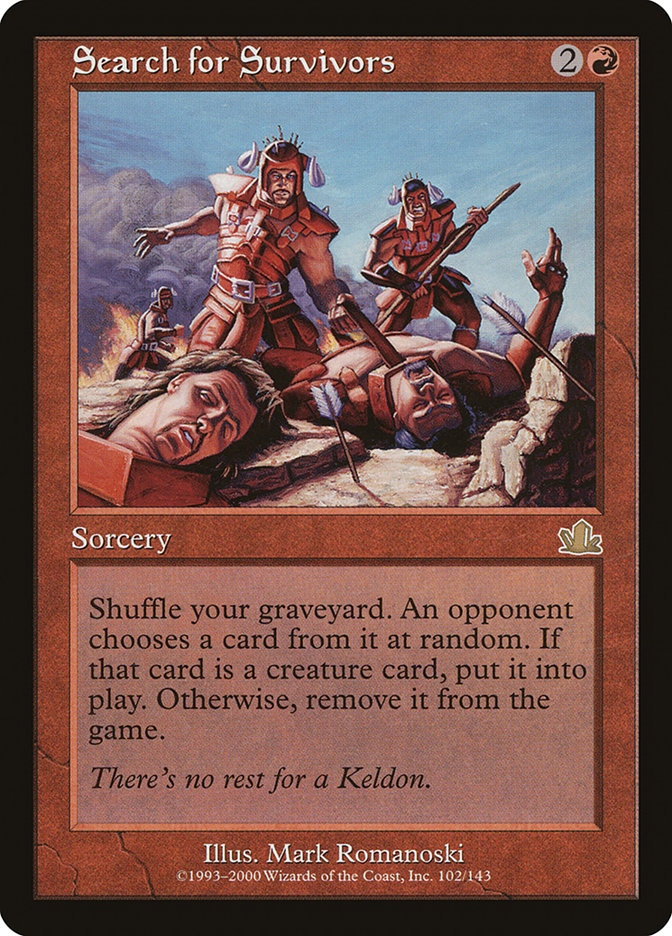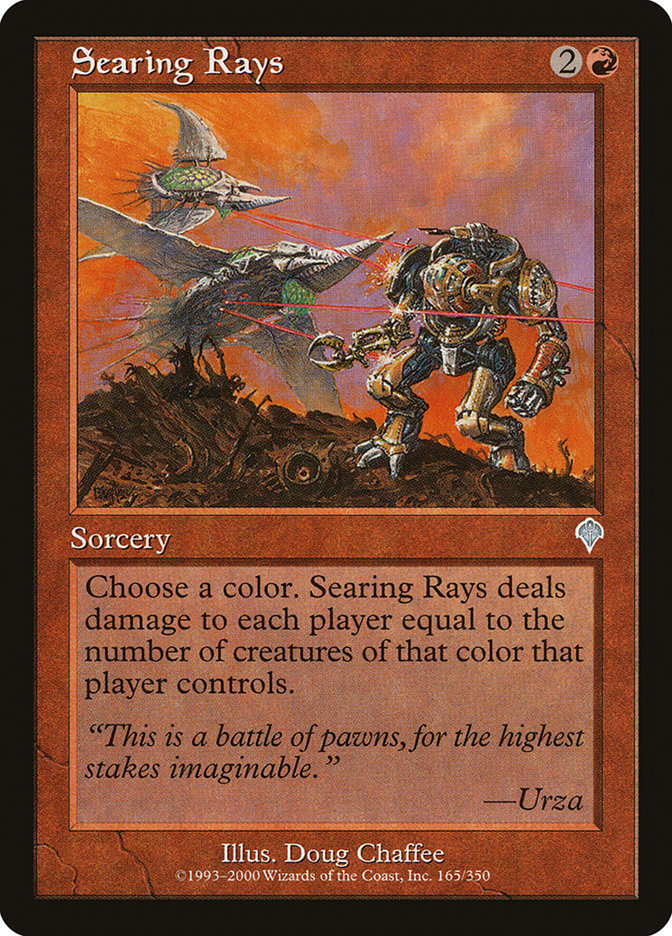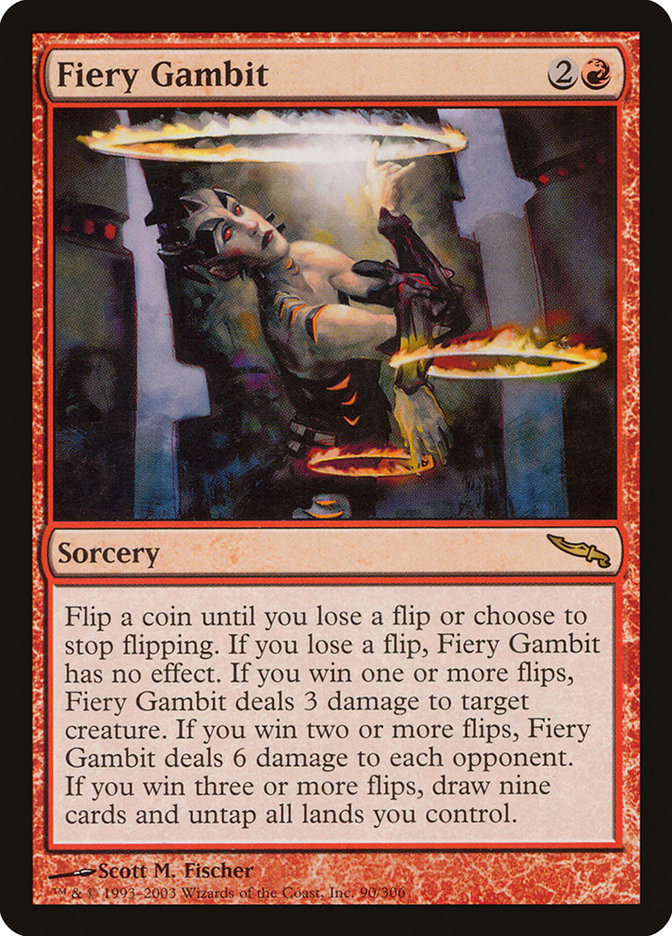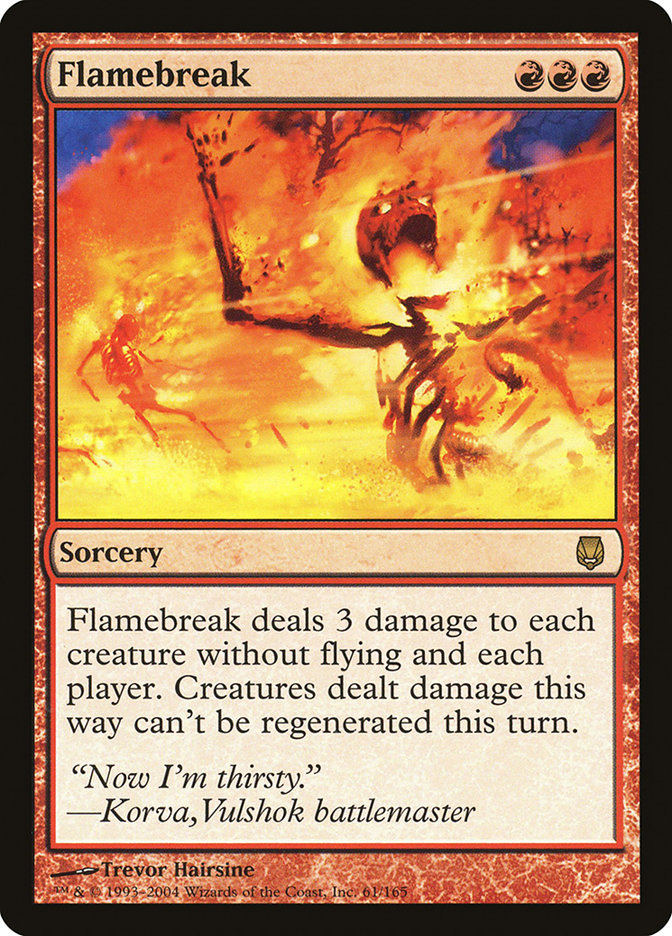Howl of the Horde MTG Card
| Mana cost | |
| Converted mana cost | 3 |
| Rarity | Rare |
| Type | Sorcery |
| Abilities | Raid |
| Released | 2014-09-26 |
| Set symbol | |
| Set name | Khans of Tarkir |
| Set code | KTK |
| Number | 112 |
| Frame | 2015 |
| Layout | Normal |
| Border | Black |
| Illustred by | Slawomir Maniak |
Text of card
When you cast your next instant or sorcery spell this turn, copy that spell. You may choose new targets for the copy. Raid — If you attacked with a creature this turn, when you cast your next instant or sorcery spell this turn, copy that spell an additional time. You may choose new targets for the copy.
Cards like Howl of the Horde
Howl of the Horde is a dynamic red sorcery for those looking to amplify their offensive spells in their MTG gameplay. It’s often likened to other spell-copying cards such as Reverberate, with key differences setting it apart. While both cards offer the ability to copy a spell, Howl of the Horde introduces a raid mechanic that can potentially double its effect after attacking, diverging from the straightforward copying provided by Reverberate.
Twinflame is another comparable spell, allowing players to copy target creature for a turn. Twinflame differs in that it’s creature-focused and doesn’t have the conditional raid bonus. Players seeking to multiply damage or other spell effects might lean towards Howl of the Horde for potentially greater impact. Wild Ricochet is worth mentioning too, with the ability to not only copy but also redirect a spell. Although more versatile, it is also more mana-intensive compared to Howl of the Horde’s three mana cost.
Exploring these comparisons reveals that Howl of the Horde, with its unique raid mechanics, stands out for players keen on capitalizing on combat-driven strategies within their MTG deck builds, whereas alternatives may be preferred in different contexts or deck themes.
Cards similar to Howl of the Horde by color, type and mana cost
Card Pros
Card Advantage: Howl of the Horde has the potential to triple the impact of your next spell, offering a significant advantage if used strategically. The ability to copy spells not only maintains but can scale up your card power during critical turns.
Resource Acceleration: Though the card itself doesn’t directly generate resources, the copies it produces can amplify spells that ramp your mana, effectively accelerating your available resources and the threat level you present to opponents.
Instant Speed: Even though Howl of the Horde is a sorcery, it synergizes well with instant-speed spells that follow. By attacking first, then casting it, you ensure that any instant you cast afterward is copied, adding a layer of surprise and potential for a game-changing play.
Card Cons
Discard Requirement: Howl of the Horde may require a sacrifice of tempo as it necessitates attacking with a creature before you can reap its benefits. This can strain your resources if you haven’t established a solid battlefield presence.
Specific Mana Cost: Costing two red mana and one of any color, Howl of the Horde demands heavy investment in red mana sources, which can restrict deck-building options and make it challenging to cast in multicolored decks.
Comparatively High Mana Cost: With a casting cost of three mana, Howl of the Horde sits at a higher echelon on the mana curve for sorceries with similar effects. This can hinder its playability, especially when facing fast-paced decks or when trying to maintain mana efficiency in the early to mid-game stages.
Reasons to Include in Your Collection
Versatility: Howl of the Horde is incredibly flexible and can enhance any deck that aims to cast powerful spells. It enables copying any instant or sorcery, making it a valuable asset in strategies that revolve around dealing damage, drawing cards, or controlling the board.
Combo Potential: This card opens the door for explosive plays. Whether you’re doubling up on damage spells for a quick win or copying key utility spells for game-changing effects, Howl of the Horde elevates the potential of your deck’s synergies significantly.
Meta-Relevance: As the meta shifts and decks become more spell-heavy, Howl of the Horde remains a pertinent choice. It works exceptionally well in a red deck that wants to maximize the impact of each spell cast, especially in environments where players cast numerous spells in a single turn.
How to Beat
Dealing with the fierce capability of Howl of the Horde from Magic: The Gathering requires a tactical approach, as this card can amplify the potency of your opponent’s next spell. To neutralize this surge, countering the initial spell is key. This can prevent the cascade of copies provided by Howl of the Horde. Leaning towards instant speed removal spells or counter spells, such as Negate or Disdainful Stroke, can disrupt your opponent’s carefully laid plans.
Timing matters greatly when facing cards with such duplicative potential. By keeping mana open, you position yourself to react swiftly and decisively. Furthermore, utilizing spells that wipe the slate clean, like board clearings, can minimize the damage caused by multiple instances of any sorceries or creatures that may have been replicated. Also consider deploying hand disruption tactics, like Thoughtseize or Inquisition of Kozilek, to remove the threat before it’s even casted, ensuring Howl of the Horde never gets its howl heard on the battlefield.
In summary, to beat Howl of the Horde, readiness and strategic denial are your greatest allies, letting you maintain control and dilute the roar of your opponent’s ensuing magic to a mere whisper.
BurnMana Recommendations
Mastering MTG involves not only understanding individual cards but also recognizing their potential synergy within your deck. Howl of the Horde is a multifaceted card that can exponentially increase the power of your spells, offering thrilling combo possibilities and game-turning swings. Effective in decks focused on spell-slinging and surprise attacks, it allows for profound tactical plays when you time it perfectly post-combat. To make the most of this card’s abilities, continue to explore and experiment with your deck’s strategy to fully harness its spell-copying prowess. Keen to harness the howl? Discover deeper strategies and synergies with us and optimize your deck’s potential.
Where to buy
If you're looking to purchase Howl of the Horde MTG card by a specific set like Khans of Tarkir, there are several reliable options to consider. One of the primary sources is your local game store, where you can often find booster packs, individual cards, and preconstructed decks from current and some past sets. They often offer the added benefit of a community where you can trade with other players.
For a broader inventory, particularly of older sets, online marketplaces like TCGPlayer, Card Kingdom and Card Market offer extensive selections and allow you to search for cards from specific sets. Larger e-commerce platforms like eBay and Amazon also have listings from various sellers, which can be a good place to look for sealed product and rare finds.
Additionally, Magic’s official site often has a store locator and retailer lists for finding Wizards of the Coast licensed products. Remember to check for authenticity and the condition of the cards when purchasing, especially from individual sellers on larger marketplaces.
Below is a list of some store websites where you can buy the Howl of the Horde and other MTG cards:
 BUY NOW
BUY NOW BurnMana is an official partner of TCGPlayer
- eBay
- Card Kingdom
- Card Market
- Star City Games
- CoolStuffInc
- MTG Mint Card
- Hareruya
- Troll and Toad
- ABU Games
- Card Hoarder Magic Online
- MTGO Traders Magic Online
See MTG Products
Legalities
Magic the Gathering formats where Howl of the Horde has restrictions
| Format | Legality |
|---|---|
| Historicbrawl | Legal |
| Historic | Legal |
| Legacy | Legal |
| Oathbreaker | Legal |
| Gladiator | Legal |
| Pioneer | Legal |
| Commander | Legal |
| Modern | Legal |
| Vintage | Legal |
| Duel | Legal |
| Explorer | Legal |
| Penny | Legal |
| Timeless | Legal |
Rules and information
The reference guide for Magic: The Gathering Howl of the Horde card rulings provides official rulings, any errata issued, as well as a record of all the functional modifications that have occurred.
| Date | Text |
|---|---|
| 2014-09-20 | Each copy will have the same targets as the spell it’s copying unless you choose new ones. You may change any number of the targets, including all of them or none of them. If, for one of the targets, you can’t choose a new legal target, then it remains unchanged (even if the current target is illegal). You can choose different targets for each copy. |
| 2014-09-20 | Howl of the Horde creates a delayed triggered ability that triggers when you cast your next instant or sorcery spell that turn. The raid ability creates a second, identical delayed triggered ability. Each of these will create a single copy of the next instant or sorcery spell you cast during that turn. If you don’t cast another instant or sorcery spell during that turn, both delayed triggered abilities will cease to exist. |
| 2014-09-20 | If the spell being copied has an X whose value was determined as it was cast (like Crater’s Claws has), each copy will have the same value of X. |
| 2014-09-20 | If the spell being copied is modal (that is, it says “Choose one —” or the like), each copy will have the same mode. You can’t choose a different one. |
| 2014-09-20 | The delayed triggered abilities will copy any instant or sorcery spell, not just one with targets. |
| 2014-09-20 | When either ability resolves, it creates a copy of the instant or sorcery spell. You control each copy. Each copy is created on the stack, so it’s not “cast.” Abilities that trigger when a player casts a spell won’t trigger. The copy or copies will then resolve like normal spells, after players get a chance to cast spells and activate abilities. |
| 2018-01-19 | Raid abilities care only that you attacked with a creature. It doesn’t matter how many creatures you attacked with, or which opponent or planeswalker controlled by an opponent those creatures attacked. |
| 2018-01-19 | Raid abilities evaluate the entire turn to see if you attacked with a creature. That creature doesn’t have to still be on the battlefield. Similarly, the player or planeswalker it attacked doesn’t have to still be in the game or on the battlefield, respectively. |
